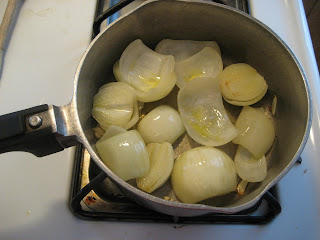
One of my favorite recipes comes originally from Claudia Roden's Book of Jewish Food. It is called poulet aux olives, and involves the braising of chicken pieces in olive oil, followed by the addition of onions, garlic, ginger, parsley, tomatoes, lemon juice, and finally blanched olives. As the chicken finishes cooking in all this, everything simmers into an aromatic sauce to be served over rice.
I find that braising chicken in this way turns the meat rubbery and, of course, makes the skin soft and unpalatable. So I've tweaked the recipe. I buy a four and a half pound whole chicken, and roast it at 325 degrees for about two and a half hours. (True professionals will gasp that this makes for one mighty overdone chicken, but I don't like having to guess whether the "juices are running clear and the meat is done." I let the bird rest half an hour under a tent of foil after bringing it out of the oven, and it turns out quite nice.)

As the chicken roasts, I use a bulb baster every so often to siphon off the drippings from the pan. Putting them into a pyrex cup lets the fat rise to the top and the clear juices settle below.

About an hour before I want to serve dinner, I begin making the sauce. This is very simple. Saute one or two onions in olive oil until they soften and turn golden.

Then, add a clove or two of minced garlic, and a half teaspoon of ground ginger. (I'm sure freshly grated ginger would be better, but I must admit I have never tried it.) Stir this briefly, just to warm the garlic -- nothing will ruin a dish as fast as burnt garlic will -- and then add some sliced tomatoes.

Now, add the drippings from the pyrex cup, by using a bulb baster again to siphon off the clear chicken juices from underneath the layer of fat floating on top. All this will then go on the back burner of your stove, along with a handful of parsley. It can simmer twenty or thirty minutes or so, until the tomatoes fall apart; meanwhile you can cook some rice and a vegetable.

You can add the olives at any time, really; the original recipe calls for them to be added at the last five minutes of cooking, but I put them in pretty much at the same time as the chicken drippings, just so I don't forget them. I use one small can of sliced black olives and a 7 ounce jar of sliced green olives, both drained of their brine. When the olive sauce is cooked through, and your rice and vegetable are done, it's time to eat.

And what wine will pair with this? I had on hand, European-style, a Vouvray from a reliable producer, Barton & Guestier. It cost less than $8 at the grocery store. The wine has a rich, almost-sweet start, but a dry and somewhat acidic finish that seemed to complement the olives and the ginger, which is probably the signature underlying taste of the dish. Olives and olive oil being things the Jews picked up in their long historic sojourn in Spain, I wonder if a Spanish Rioja would have been a suitable red ....



No comments:
Post a Comment
Thanks for stopping by ...